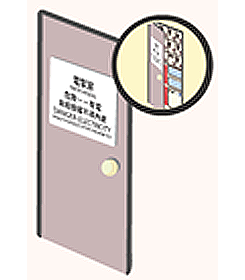(B) Electrical Installations
(6) Communal Electrical Installations
- 1.Communal electrical installations in a building include:
- the main switch, sub-circuit switches for supplying power to all individual residential units and shops in that building;
- electrical wiring (e.g. risers); and
- other communal electrical facilities (e.g. lifts, water pumps and lighting facilities at lobbies, staircases and corridors).
1.Owners of communal electrical installations in a building include the incorporated owners and the property management company of that building. If there is no incorporated owners, owners of communal electrical installations include the landlords, occupiers and tenants of all the individual residential units and shops. |
 |
2.Switchroom should have suitable means of entrance / exit in order to prevent entry by unauthorised person. The warning notice “DANGER — ELECTRICITY, UNAUTHORISED ENTRY PROHIBITED” for switchroom should be placed on the outside of the door of the switchroom. |
|
3.Registered electrical contractors shall be arranged to carry out any electrical work (e.g. addition to, alteration of, inspection, testing and repair of an electrical installation, including those in connection with a renovation work). After inspection and testing, the registered electrical contractor and registered electrical worker shall issue a Work Completion Certificate (Form WR1) to confirm that the electrical installation is safe and complies with the statutory safety requirements. |
|
4.To ensure safety, any electrical installation in a residential unit, shop and office and the communal electrical installation of any building must be inspected, tested and certified on a Periodic Test Certificate (Form WR2) at least once every 5 years if the approved loading exceeds 100A. |
